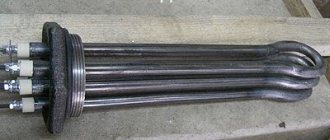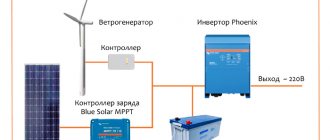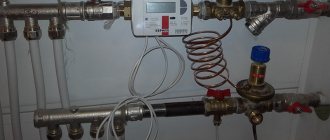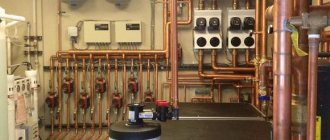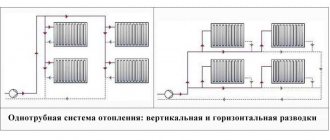The rise in energy prices stimulates the search for more efficient and cheaper types of fuel, including at the household level. Most of all craftsmen - enthusiasts are attracted by hydrogen, whose calorific value is three times higher than that of methane (38.8 kW versus 13.8 from 1 kg of substance). The method of extraction at home, it would seem, is known - the splitting of water by electrolysis. In reality, the problem is much more complicated. Our article has 2 goals:
The power sector has probably produced more electricity with gas than coal. Both fuels currently account for about 33 percent, according to federal energy sources. However, gas fuel is not controversial. Production from shale formations using horizontal drilling and hydraulic fracturing, which has provided much of the production growth over the past decade, has polluted some waterways and caused earthquake problems.
M of gas per day on average last year. It didn't have to be this way. In recent years, the coal industry has been beaten by competition from cheap gas and clean regulations that have raised the cost of burning dirty black rock. The gas trend is here to stay. Generators are adding more gas installations as older coal-fired power plants retire, Costas said.
- analyze the question of how to make a hydrogen generator with minimal costs;
- consider the possibility of using the installation for heating a private house, refueling a car and as a welding machine.
Hydrogen, aka hydrogen, - the first element of the periodic table - is the lightest gaseous substance with high chemical activity. During oxidation (that is, combustion), it releases a huge amount of heat, forming ordinary water. Let us characterize the properties of the element, formulating them in the form of theses:
With electricity and gas, you pay for two main things. The energy you use is wasting energy in your home. ... Only over a third of what you pay is getting energy for you - the rest is what you use. A small portion of what you pay also goes to finance the work of energy industry regulators.
* The numbers we are missing do not highlight the transmission costs from the power charges. There are a number of processes for securing your home - and you end up paying for these processes in your bill. Your bill covers the generation, transmission, distribution and retail of electricity. It also includes a small levy that is administered by the Electricity Authority, which regulates and regulates the electricity industry.
For reference. Scientists, who first split the water molecule into hydrogen and oxygen, called the mixture an explosive gas because of its tendency to explode. Subsequently, it received the name of Brown's gas (by the name of the inventor) and began to be designated by the hypothetical formula NNO.
First, your strength must be generated. In New Zealand, this is mainly from hydropower, geothermal energy and natural gas. Transmission is the massive movement of energy across the country. Electricity is transmitted from the power plant to a distribution point near your home.
The main transmission channel is vector driven. From there, your power is distributed.Distribution of energy from the point of delivery or distribution to your property is handled by local distribution companies - either lines or grid companies, or, in the case of gas, gas grid companies.
Previously, airship cylinders were filled with hydrogen, which often exploded.
From the above, the following conclusion suggests itself: 2 hydrogen atoms easily combine with 1 oxygen atom, but they part very reluctantly. The chemical oxidation reaction proceeds with the direct release of thermal energy in accordance with the formula:
Electricity transmission and distribution costs are usually paid by your retailer and included as part of what they charge you. In some cases, retailers separate the different components of your bill so you can see what you are paying for each portion. In several areas, the grid company bills directly for distribution costs.
Gas transmission and distribution costs are included in the wholesale price when retailers purchase gas. The share of your bill covering transmission and distribution is higher for gas than for electricity. Your retailer is the energy company you do business with that sends you your invoice.
2H 2 + O 2 → 2H 2 O + Q (energy)
Here lies an important point that will be useful to us in further debriefing: hydrogen reacts spontaneously from ignition, and heat is released directly. To separate a water molecule, energy will have to be spent:
2H 2 O → 2H 2 + O 2 - Q
This is an electrolytic reaction formula that characterizes the process of splitting water by supplying electricity. How to implement this in practice and make a hydrogen generator with your own hands, we will consider further.
Retailers buy electricity generated by generating companies in a complex trading system. For electricity, this is called the New Zealand electricity market. It is at this level of electricity trading that you will hear terms such as "wholesale market" and "spot pricing". The wholesale price that retailers buy electricity at can greatly affect the price you pay.
Electric generators sell electricity on the wholesale market. It is bought by sellers who then sell it to you. While the price of electricity is set every half hour and varies based on demand, most retailers sell it to you at a set price and usually arrange buy-sell contracts known as “hedges” with wholesalers.
Creation of a prototype
So that you understand what you are dealing with, we first propose to assemble the simplest generator for the production of hydrogen at minimal cost. The design of a homemade installation is shown in the diagram.
There are some retailers who will sell you electricity on a contract price basis - so what you pay depends on changes in the spot price. There is a price margin for the retailer, but since the retailer does not have to cover fluctuations in the spot price, the margin is less than for the specified contract price. So on average, buying locally priced is cheaper but more risky than priced contracts.
The owners of the gas field pay royalties to the government and then sell the gas to wholesalers, who sell it to retailers. Gas and electricity markets are levied to pay the regulatory authorities that supervise them and to provide services to resolve consumer complaints. Energy industry regulation fees are extremely low.
What a primitive electrolyser consists of:
- reactor - glass or plastic container with thick walls;
- metal electrodes immersed in a water reactor and connected to a power source;
- the second reservoir acts as a water seal;
- pipes for the removal of HHO gas.
An important point. The electrolytic hydrogen plant operates on direct current only. Therefore, use the AC adapter, car charger or battery as the power source. An AC generator will not work.
Compare your electricity bill and save
Find out who is supplying your new property and how to get the best gas and electricity deal. A switch supplier is a quick and easy way to reduce household costs. With so many tasks on your moving home checklist, remembering to notify your current energy supplier - and figuring out who your new gas and electricity supplier is - will probably be the last in your mind.
Find out who is supplying gas and electricity to the new property
The good news is that these two tasks are not as hard to mark your list as you might think. If you cannot get this information from your current tenants, you can make a couple of calls to find out who your new energy provider is. You can call your electricity distribution area to find out who is supplying your electricity. The numbers are listed below.
The principle of operation of the electrolyzer is as follows:
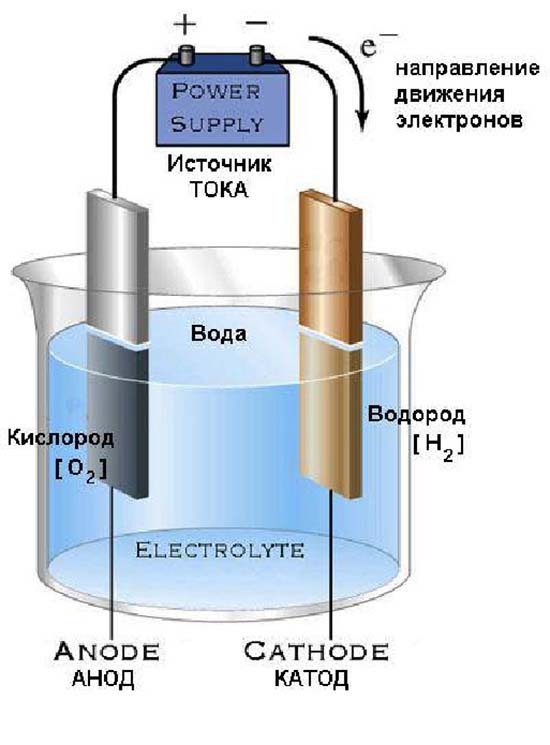
To make the generator design shown in the diagram with your own hands, you will need 2 glass bottles with wide necks and lids, a medical dropper and 2 dozen self-tapping screws. The complete set of materials is shown in the photo.
Thermogenerators. History and theory
A moving day is a stressful time, but remember to take care of a few gas and electricity details while you load your boxes. You will be grateful later when you receive new bills in order. Now that you've moved on to your new property, you're almost done!
Why pay more for the same energy?
Contact your supplier for new property to inform them of your move and provide your testimony.
- Take the counter reading in the new property.
- Do this as soon as possible to ensure an accurate first count.
Find and switch to the best energy deal in minutes.
Special tools will require a glue gun to seal the plastic lids. The manufacturing procedure is simple:
To start the hydrogen generator, pour salted water into the reactor and turn on the power source. The beginning of the reaction will be marked by the appearance of gas bubbles in both containers. Adjust the voltage to the optimum value and ignite the Brown gas coming out of the dropper needle.
Frequently Asked Questions About Moving Home and Energy Suppliers
What if my new property has a prepayment meter
Learn more about the economy of 7 meters, including how your type of meter is through your supplier. What if my new property is not gas or electricity related. If your new property is not connected to the gas or electricity network, you will need to request a connection from the gas vehicle operator or distribution network operator.
How to take readings from a gas meter or readings from an electricity meter?
Alternatively, you can contact your preferred provider first and request a connection through them. A connection fee will be charged. If you've never read a gas or electricity meter, this may seem daunting. But don't worry, we have a step-by-step video to help you find your meters, if you don't know where the property is, determine which meters you have and of course read the meter.
The second important point. Too high a voltage cannot be applied - the electrolyte, heated to 65 ° C or more, will begin to evaporate rapidly. Due to the large amount of water vapor, the burner cannot be ignited.For details of assembling and starting an impromptu hydrogen generator, see the video:
Renters Switching Guide Even if you rent you, you can still switch energy.
- Tenants can ask their landlord to switch energy.
- Find an energy supplier.
- You get the best deal for your gas and electricity.
Not too long ago, natural gas - the fuel your hot shower probably gave you this morning - was perceived as a cleaner "bridge" fuel because it was less polluted than other alternatives. For some purposes, it still exists, such as when it replaces diesel in buses.
What do we choose from and what factors do we rely on
Trunk gas, as a fuel, is unrivaled. If possible, only he. If there is no gas, or it is not possible to conduct it, then it is worth choosing another option. What factors to pay attention to when choosing? It:
- price,
- convenience,
- availability,
- installation costs,
- payback period,
- conditions and restrictions.
And we choose from several types of fuel. For comparison, the gas is also decomposed according to the criteria. It seemed to us that the table would more clearly show the difference and help you choose the best option for the energy source.
| Natural gas | Liquefied gas | Electricity | Firewood | Coal | Pellets | Liquid fuel | |
| Approximate price for a house of 100m2 for the heating season (7 months) | 5000 | 25000 | 34000-36000 | 12000-16000 | 4000 | 13000 | 27000-30000 |
| Fuel availability | It is not accessible to everyone, even if the highway passes next to the house, it is expensive to lead into the house. | Depending on the area, it is more often available. | Depending on the area. | Available fuel | Available fuel | Depending on the area | Depending on the area |
| Installation costs, rubles | It costs up to 800 thousand rubles to bring gas to the house. | Up to 300 thousand rubles. | Up to 50 thousand rubles. | 70-100 thousand rubles. | Up to 300 thousand rubles. | Up to 200 thousand rubles. | Up to 500 thousand rubles. |
| Boiler efficiency | 90% | 90% | 93-99,3% | 70% | 75% | 85% | 90% |
| Payback period | 6.9 years | 21 years old | It is difficult to talk about payback at the highest resource cost and not expensive equipment | 2.5-3 years | 1.8 years | 4.5 years | 9.7-10 years |
| Environmental friendliness | Environmentally friendly fuel | Least emissions | In the process of using an environmentally friendly resource | Increased soot content | Black smoke, soot, smell | Increased soot content | Black smoke, smell |
| Storage | Not required | Requires a gas tank or space for cylinders | Not required | Need a lot of space for stocks of firewood | Difficult to store and move, a lot of dirt, dust, waste | Need a lot of space | A tank is needed: up to 50 liters, it is placed in the house. Above this volume, they are buried on the site or build a separate room. There are fire safety regulations and rules. |
| Loading | Not required | When emptying a gas cylinder or gas tank | Not required | Up to three times a day, manual | From 1 time per day | Once a week | Not required |
| Complexity of service | At least once a year. | At least once a year. | At least once a year. | 1 time per month. | 1 time per month. | Check the condition of the combustion chamber and chimney once a month. | Irregular maintenance, time-consuming process, it is difficult to clean the boiler with low-quality fuel. |
| Conditions and restrictions | High fees for connecting to the main gas pipeline. Complex system of approvals. High fire hazard of fuel. | Frequent delivery and replacement of cylinders. If you use a large capacity, it is expensive. It takes place on the site where it is buried. Explosive. | There are consumption restrictions, volatility | You need to take care of large reserves for the winter. No automatic download. Suitable for houses over 150-200 m2. | Problems with the organization of storage. It is necessary to remove waste, strong dustiness of equipment and yard. Manual fuel supply. | In some areas, this type of fuel is difficult to obtain. | High toxicity of gases during fuel combustion. You need to think over the storage and do frequent inspections of the equipment. |
Having decided on the energy source, it's time to understand what the equipment is for each type of fuel
About Meyer's hydrogen cell
If you have made and tested the above design, then by the burning of the flame at the end of the needle, you probably noticed that the productivity of the installation is extremely low. To get more oxyhydrogen gas, you need to make a more serious device, called a Stanley Meier cell in honor of the inventor.
But in our homes, some believe that natural gas should be phased out in favor of electrical appliances for climate reasons. There is already a tendency to switch from gas to electricity. S. is fully electric. This trend is strongest in the south. When it is burnt, or especially if it leaks out unburned, natural gas contributes to climate change.
Plate reactor
Thomsen and several others have recommended a type of heating and air conditioning known as heat pumps. He believes that the future is electrification of homes. He recommends them for people who have solar systems on their roofs, as electricity is paid for.
The principle of operation of the cell is also based on electrolysis, only the anode and cathode are made in the form of tubes inserted into one another. The voltage is supplied from the pulse generator through two resonant coils, which reduces the current consumption and increases the performance of the hydrogen generator. The electronic circuit of the device is shown in the figure:
He installs them in affordable apartments all over California. “A refrigerator uses more electricity for heating and cooling than a heat pump in an apartment,” Armstrong said. But gas utilities say natural gas helps maintain energy availability. Many people struggle to pay their utility bills and cannot risk it.
True, it is even more expensive than gas in most of the applications we use now, he said. When people switch from gas to electricity, sometimes they have to increase the electrical maintenance in the circuit breaker box and the other cost. Harris agrees that the electricity is getting cleaner. But he said that installing wind turbines and solar farms also requires the use of fossil fuels. They require a lot of concrete, and the energy for producing and pouring concrete comes from fossil fuels.
Note. Details about the operation of the scheme are described on the resource https://www.meanders.ru/meiers8.shtml.
To make a Meyer cell you will need:
- a cylindrical body made of plastic or plexiglass, craftsmen often use a water supply filter with a cover and nozzles;
- stainless steel tubes with a diameter of 15 and 20 mm and a length of 97 mm;
- wires, insulators.
Research still shows that wind and solar farms tend to make up for this fossil fuel use not too long after they start operating. About 11% of Germany's electricity was generated by gas-fired power plants. In addition, gas-fired power plants achieve very high efficiency rates thanks to sophisticated technology, converting most of the energy from natural gas into electricity. By comparison, coal-fired power plants can achieve 50% efficiency at best.
Atmospheric lighting sources
Gas-fired power plants are becoming more efficient thanks to the improvements made in turbines over the past few decades. They are powered by burning natural gas, which heats incoming air and drives turbines, in a similar process to a jet plane. The rotational motion is transmitted through the shaft to an electric generator, which generates electricity like a bicycle dynamo.
Stainless tubes are attached to a dielectric base, wires connected to the generator are soldered to them.The cell consists of 9 or 11 tubes, placed in a plastic or plexiglass case, as shown in the photo.
The elements are connected according to all the scheme known on the Internet, which includes an electronic unit, a Meyer cell and a water seal (technical name is a bubbler). For safety reasons, the system is equipped with critical pressure and water level sensors. According to home craftsmen, such a hydrogen plant consumes a current of about 1 ampere at a voltage of 12 V and has sufficient performance, although there are no exact figures.
Schematic diagram of switching on the electrolyzer
Main characteristics
When choosing a specific model of the device, its tasks and technical characteristics are taken into account.
Power
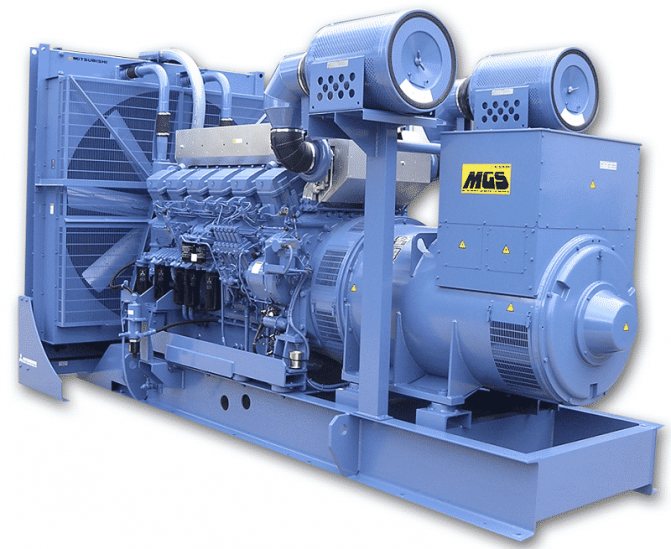

A powerful gas electric generator is able to provide all appliances in the house with power
The power of the unit depends on how many devices the gas generating station can supply. The indicator ranges from 2-500 kW.
The main groups of devices:
- Up to 10 kW. Installed as a backup source of electricity in the country or in a private house. You can connect a refrigerator, lighting, air conditioning to it. Sometimes you can run a washing machine or microwave.
- 10 to 25 kW. Such gas generators of electricity are used for the autonomous supply of country houses and cottages. They allow the connection of all household appliances with a high starting factor.
- More than 25 kW. They are installed to supply power to several houses, a construction site, a production workshop.
To ensure uninterrupted power supply to all household equipment, it is necessary to summarize the power of all appliances connected to the network. In addition to the resulting value, 20-30% of the stock is added.
Cooling system
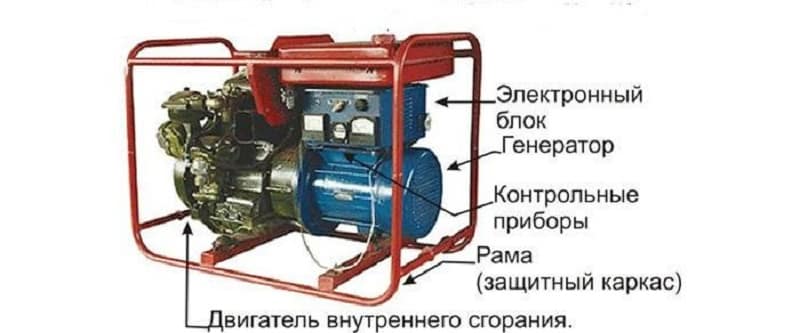

In household appliances, cooling occurs with air
The gas generator for electricity works properly if it does not overheat. To prevent the problem, several types of cooling systems are used: air and water. The first option is natural (suitable for open devices with minimal power) and forced. The engine and generator are blown from different directions.
Water cooling is suitable for powerful devices (from 20 kW) in industrial plants. It normalizes the temperature of the generator and allows it to be used for heating or hot water supply. The system is practically silent during operation.
Duration of work


Emergency start gas generators are capable of operating no more than 12 hours
According to the duration of work, the following devices are distinguished:
- Constant action. This is a self-contained unit that fully supplies household appliances with electricity. Without a break, such a unit is capable of operating up to 20 hours. It is equipped with an automatic control system (on-off), as well as water cooling. The apparatus is periodically stopped to change the oil.
- Periodic power supply. The devices are installed in summer cottages or industrial workshops with a variable work schedule. The maximum running time is 12 hours. Since the device is equipped with an air cooling system, a longer period of operation is not possible.
- Emergency start. They are not used for the constant supply of electricity to the house. Such devices are needed if the power in the main network is turned off for a while.
All types of devices can be used for domestic use. It takes into account what functions the unit must perform.
Fuel type
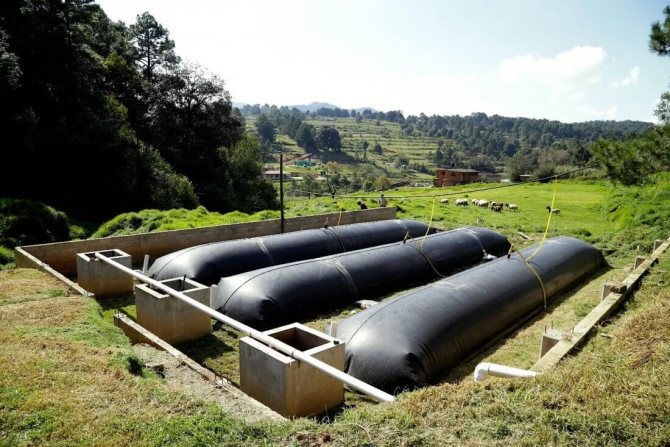

The generator is capable of running on biogas
Electric generators work on gas. If there is no central line, it is allowed to use cylinders with liquefied fuel. If available, a utility permit is required to connect. The pressure in the network corresponds to 1.3-2.5 kPa. Instead of the classic version of the fuel, butane, propane, biogas can be used.The pressure when using liquefied fuel is 2-6 kPa.
The sizes of gas generators depend on their capacity. Minimum values: 2m * 1m * 1m, maximum - 5m * 2m * 2m.
Plate reactor
A high-performance hydrogen generator capable of ensuring the operation of a gas burner is made of stainless plates 15 x 10 cm in size, the number is from 30 to 70 pieces. Holes are drilled into them for tightening pins, and a terminal is cut out in the corner for connecting the wire.
In addition to stainless steel sheet grade 316, you will need to buy:
- rubber with a thickness of 4 mm, resistant to alkali;
- end plates made of plexiglass or textolite;
- tie studs M10-14;
- check valve for gas welding machine;
- water filter for a water seal;
- corrugated stainless steel connecting pipes;
- potassium hydroxide in powder form.
The plates must be assembled into a single block, insulating from each other with rubber gaskets with a cut out center, as shown in the drawing. Pull the resulting reactor tightly with pins and connect it to the electrolyte pipes. The latter comes from a separate container equipped with a lid and shut-off valves.
Note. We tell you how to make a flow-through (dry) type electrolyzer. It is easier to manufacture a reactor with immersed plates - there is no need to put rubber gaskets, and the assembled block is lowered into a sealed container with electrolyte.
Wet type generator circuit
The subsequent assembly of a generator producing hydrogen is carried out according to the same scheme, but with differences:
- A reservoir for electrolyte preparation is attached to the body of the apparatus. The latter is a 7-15% solution of potassium hydroxide in water.
- Instead of water, a so-called deoxidizer is poured into the bubbler - acetone or an inorganic solvent.
- A non-return valve must be installed in front of the burner, otherwise, when the hydrogen burner is smoothly turned off, the back blow will rupture the hoses and the bubbler.
The easiest way to power the reactor is to use a welding inverter; there is no need to assemble electronic circuits. How does Brown's homemade gas generator work, the home master will tell in his video:
Is it profitable to get hydrogen at home?
The answer to this question depends on the scope of application of the oxygen-hydrogen mixture. All drawings and diagrams published by various Internet resources are designed to release HHO gas for the following purposes:
- use hydrogen as fuel for cars;
- smokelessly burn hydrogen in heating boilers and furnaces;
- apply for gas welding.
The main problem that negates all the advantages of hydrogen fuel: the cost of electricity for the release of a pure substance exceeds the amount of energy obtained from its combustion. Whatever the adherents of utopian theories claim, the maximum efficiency of the electrolyzer reaches 50%. This means that 2 kW of electricity is consumed per 1 kW of heat received. The benefit is zero, even negative.
Let's remember what we wrote in the first section. Hydrogen is a highly active element and reacts with oxygen on its own, generating a lot of heat. Trying to split the stable water molecule, we cannot bring energy directly to the atoms. The splitting is carried out by electricity, half of which is dissipated for heating the electrodes, water, transformer windings, and so on.
Important background information. The specific heat of combustion of hydrogen is three times higher than that of methane, but by weight. If we compare them by volume, then when 1 m³ of hydrogen is burned, only 3.6 kW of thermal energy will be released versus 11 kW for methane. After all, hydrogen is the lightest chemical element.
Now consider the oxyhydrogen gas obtained by electrolysis in a home-made hydrogen generator as fuel for the above needs:
For reference. To burn hydrogen in a heating boiler, the structure will have to be thoroughly redesigned, since a hydrogen burner can melt any steel.
Best gas generators
Generac 6520
The 5.6 kW air-cooled model belongs to the POWER PACT series... The gas generator will be the ideal choice for back-up power supply to a private house or cottage.
The device has a soundproof casing, a single-cylinder GENERAC gas engine.
Recommended for outdoor installation... Cylinder or main gas can be used as fuel.
It functions in manual and automatic modes. For the latter option, it is recommended to purchase an additional automation unit.
To start at low temperatures - with the "heating" option.
Characteristics:
- voltage - 220 V;
- engine displacement - 420 cubic meters. cm, type - four-stroke, number of revolutions - 3,000;
- active power - 5 kW, full - 5 kW, current - 22.7 A;
- noise - 60 dB;
- there is a muffler, noise suppression casing;
- dimensions - 95.7x64.3x68 cm;
- weight - 115 kg.
Dignity:
- quick engine start in any weather;
- quiet work;
- fuel economy;
- safe operation;
- uninterrupted power supply;
- indicators on the control panel are highlighted by LEDs;
- clear operation of the indicator (general condition of the unit);
- simple maintenance.
disadvantages:
- not.
Russian Engineering Group GG7200-A
This model is suitable for creating a backup power source not only in residential buildings, but also on construction sites, offices.
The design is able to turn off the engine in automatic mode if the oil level falls below normal.
Thanks to the metal power frame, the generator is firmly fixed on the base, protected from various damages.
The stick and wheels increase the maneuverability of the machine when transporting around the work area is required. The front panel is equipped with sockets, which in turn are protected by covers.
Characteristics:
- start type - electric and manual;
- voltage - 220 V;
- the engine series is FH420, its volume is 420 cc. cm;
- 1 cylinder, four-stroke, number of revolutions - 3,000;
- air cooling;
- generator type - synchronous;
- active power - 5.5 kW, maximum - 6 kW, total - 5.5 kW;
- noise - 75 dB;
- has wheels, muffler, overload protection, voltmeter, hour meter;
- number of sockets - 2 for 220 V and 1 for 12 V;
- dimensions - 77.5x66x64.5 cm;
- weight - 91 kg.
Dignity:
- counter with three positions - frequency, engine hours, voltage;
- the engine has high performance;
- a wide range of fuels - methane, propane-butane, biogas;
- uninterrupted operation, quick start at low pressure in the line;
- there is an oil level sensor;
- performance in any weather - from -30 to +40 degrees;
- long service life.
disadvantages:
- not.
BRIGGS & STRATTON 6 kW Standby Generator
Gas generator powered by B&SIntek single-cylinder engine... It forms a backup source of power supply in country houses, using liquefied or mains gas.
It can function simultaneously with the autorun system.
If you need to install the unit outdoors, then you need to purchase additional heating... This model is considered the most compact and quietest in its line.
The body is made of stainless steel, which is used in mechanical engineering. The unit is reliably protected from destruction, wear resistance.
Characteristics:
- start type - electric;
- voltage - 220 V;
- engine displacement - 500 cc, type - four-stroke;
- air cooling;
- active power - 5.4 kW;
- noise - 72 dB;
- there is a soundproof casing, muffler, overload protection;
- dimensions - 71x89x62 cm;
- weight - 114 kg.
Dignity:
- does not require a separate room for installation;
- work in any weather, at low and high temperatures;
- low operating costs;
- long service life;
- uninterrupted power supply;
- quiet work;
- automatic fuel supply;
- safe use of gas without poisoning the environment.
Disadvantages:
- not.
Russian Engineering Group GG8000-A
This model is an inexpensive power plant on wheels for use in country and private houses, at any facility..
Operates on main, natural, cylinder gas. It has a counter with three positions - frequency, engine hours and voltage. Supplied with a helium battery.
It is a synchronous brush generator with electric and manual start, the possibility of equipping with an automatic start system.
Suitable for installation inside the house, since it does not cause discomfort to residents with its work.
Characteristics:
- voltage - 220 V;
- engine type - FH420, volume - 440 cu. cm, single-cylinder, four-stroke;
- air cooling;
- active power - 6 kW, maximum - 6.5 kW, total - 6 kW;
- noise - 75 dB;
- there are wheels, a muffler, overload protection, a voltmeter, a counter;
- the number of sockets - 2 for 220 V, 1 for 12 V;
- dimensions - 74x62x55 cm;
- weight - 91 kg.
Dignity:
- quick engine start at any time of the year;
- uninterrupted operation at temperatures from -30 to +40 degrees;
- reliable functionality at low line pressure;
- the choice of fuel - methane, propane, biogas;
- the sensor shows the oil level, informs about the need to refuel;
- high-performance engine;
- convenient transportation across the area of the room.
Disadvantages:
- not.
Generac 7144
Equipped with a powerful air-cooled GUARDIAN engine... It is an ideal choice for providing a backup source of electricity in a private house, cottage.
The GENERAC G_FORCE two-cylinder engine has a special casing for noise suppression during operation, smooth operation in any weather.
Switched on using automatic (requires equipping with an automation unit) or manual mode... For a confident start at low temperatures, you must purchase a heating option.
Characteristics:
- voltage - 220 V;
- engine volume - 530 cubic meters. cm, four-stroke;
- active power - 8 kW;
- noise - 60 dB;
- there is a soundproof casing, a muffler;
- dimensions - 122.8x73.3x63.5 cm;
- weight - 155 kg.
Dignity:
- two-cylinder engine;
- convenient arrangement of parts for easy maintenance;
- uninterrupted supply of electricity at any time of the year;
- the case perfectly withstands mechanical damage, sudden temperature changes;
- clear control using the panel;
- indicators are highlighted in the dark.
disadvantages:
- not.
GVB 6000 M G
Professional station based on the Briggs and Stratton Vanguard 13 HP engine from the GVB series... It can act as a permanent or backup power source.
Great for indoor and outdoor installation.
The use of gas as a fuel ensures high environmental friendliness, since it does not form hazardous compounds during combustion..
You can get electricity from natural, liquefied gas or biogas. Thanks to the built-in pressure sensor, the owner assesses the stability of the generator even at low pressure in the gas line.
Characteristics:
- start type - manual;
- voltage - 220 V;
- engine volume - 392 cubic meters. cm, power - 13 liters. from.;
- class - one-cylinder, four-stroke, air-cooled;
- generator protection degree - IP23;
- active power - 5.4 kW, total - 5.4 kW;
- there is a muffler, overload protection;
- number of sockets - 1 for 220 V;
- dimensions - 55.5x51.5x78 cm;
- weight - 69 kg.
Dignity:
- improved engine with high performance;
- quick start in any weather, at low and high temperatures;
- the case has high protection against external adverse factors;
- relatively quiet operation;
- uninterrupted power supply;
- a wide range of gas fuels.
disadvantages:
- not.
Generac RG 027 3P
Gas generator with powerful engine that consumes fuel efficiently... The manufacturer tried to develop a unique unit that has a high degree of wear resistance and a long service life.
Electronic ignition provides a soft and quick start of the system.
If the oil level drops below normal at higher speeds, the engine will automatically shut off..
This reduces the risk of damage to the generator and its power components. Operation takes place on natural gas, liquid propane.
The uniqueness lies in the connection of the installation to a smartphone for further assessment of its condition at serious distances.
Characteristics:
- start type - electric and automatic;
- voltage - 380 and 220 V;
- engine volume - 2,400 cubic meters. cm, four-cylinder, four-stroke;
- cooling type - liquid;
- active power - 20 kW, maximum - 21.6 kW, total - 25 kW;
- there is a soundproof casing, muffler, overload protection;
- dimensions - 158x98x77.6 cm;
- weight - 425 kg.
Dignity:
- high engine power;
- True Power technology for harmonious current delivery;
- Evolution technology - controller with two-line LCD display;
- weekly automatic diagnostics;
- remote monitoring;
- aluminum case resistant to external adverse factors;
- voltage regulation.
Disadvantages:
- not.
Comfort GAZ-4.5kW-ES
Gas generator for uninterrupted electricity in private and country houses... It copes well with its duties during an emergency power outage.
Equipped with an air-cooled, single-cylinder, four-stroke engine with increased power.
Supplied with transistor ignition system... It is convenient to use liquefied or natural gas as fuel. The oil sump volume is 1 liter, which allows economical oil consumption.
Characteristics:
- start type - electric;
- voltage - 220 V;
- engine volume - 389 cc;
- fuel consumption - 1.6 l / h;
- active power - 4.2 kW, maximum - 4.5 kW;
- noise - 75 dB;
- there are wheels, a muffler, overload protection, a voltmeter;
- number of sockets - 2 x 220 V;
- dimensions - 68x55x53.5 cm;
- weight - 83 kg.
Dignity:
- efficient work at any time of the year;
- quiet engine operation;
- high quality case;
- long service life;
- convenient control;
- quick assessment of indicators;
- economical fuel and oil consumption.
Disadvantages:
- not.
Greengear GE-5000
The generator is a reliable mobile equipment based on the engine of the single-cylinder, four-stroke GG4GN engine.
Suitable for use as a main or backup source of electricity.
The engine is quiet and smooth, but evenly and uninterruptedly supplies current to all household appliances.
The covers on the sockets serve as protection against dust, moisture and dirt. Convenient transportation due to large wheels and a folding handle. They provide maneuverability and smooth running over the area of the room.
Characteristics:
- start type - electric and manual;
- voltage - 220 V;
- engine volume - 390 cubic meters. cm;
- air cooling;
- active power - 5 kW, maximum - 5.5 kW;
- there is a muffler, overload protection, hour meter;
- number of sockets - 3 for 220 V, 1 for 12 V;
- dimensions - 70x50x53 cm;
- weight - 83 kg.
Dignity:
- economical consumption of LPG or propane;
- multifunctional display with display of working time, voltage and frequency;
- powerful engine;
- high quality of structural elements;
- long service life;
- rigid frame for stability and perfect protection of the unit.
disadvantages:
- not.
Grandvolt GVB 13500 T ES G
Professional gas power plant from the GVB series based on the Vanguard engine Briggs & Stratton... Acts as a permanent or temporary power source.
An uninterrupted flow of electricity powers all household appliances, power units, and various installations.
The use of any type of gas guarantees high environmental friendliness, safety, minimum inconvenience during operation... Combustion products do not spoil the internal elements, so this model will last as long as possible.
Characteristics:
- start type - electric;
- voltage - 380 or 220 V;
- engine volume - 570 cubic meters. cm, power - 18 liters. from.;
- motor type - two-cylinder, four-stroke with an air cooling system;
- protection class - IP23; active power - 9 kW, total - 11.3 kW;
- noise - 72 dB;
- there is a muffler, overload protection;
- number of sockets - 1 for 220 V, 1 for 380 V;
- dimensions - 90x73x66 cm;
- weight - 139 kg.
Dignity:
- high power indicators;
- the engine has a smooth and quick start at any time of the year;
- suitable for installation in rooms with high humidity levels;
- durability;
- uninterrupted power supply; fuel and oil savings;
- safe operation.
disadvantages:
- not.
How to determine the thermoelectric power of a metal
The thermoelectric power of a metal is determined with respect to platinum. For this, a thermocouple, one of the electrodes of which is platinum (Pt), and the other the tested metal, is heated to 100 degrees Celsius. The resulting value in millivolts for some metals is shown below. Moreover, it should be noted that not only the magnitude of the thermopower changes, but also its sign with respect to platinum.
In this case, platinum plays the same role as 0 degrees on the temperature scale, and the entire thermopower scale looks like this:
- Antimony +4.7
- Iron +1.6
- Cadmium +0.9
- Zinc +0.75
- Copper +0.74
- Gold +0.73
- Silver +0.71
- Tin +0.41
- Aluminum +0.38
- Mercury 0
- Platinum 0
Platinum is followed by metals with a negative thermoelectric power:
Using this scale, it is very easy to determine the value of the thermoelectric power developed by a thermocouple composed of various metals. To do this, it is enough to calculate the algebraic difference in the values of the metals from which the thermoelectrodes are made. For example, for antimony - bismuth pair, this value will be +4.7 - (- 6.5) = 11.2 mV. If an iron - aluminum pair is used as electrodes, then this value will be only +1.6 - (+0.38) = 1.22 mV, which is almost ten times less than that of the first pair.
If the cold junction is maintained at a constant temperature, for example 0 degrees, then the thermoelectric power of the hot junction will be proportional to the temperature change, which is used in thermocouples.
How thermogenerators were created
Already in the middle of the 19th century, numerous attempts were made to create thermogenerators - devices for generating electrical energy, that is, for powering various consumers. Batteries made of series-connected thermoelements were supposed to be used as such sources. The design of such a battery is shown in Fig. 2.
Fig. 2. Thermopile, schematic device
The first thermoelectric battery was created in the middle of the 19th century by physicists Oersted and Fourier. Bismuth and antimony were used as thermoelectrodes, just the very pair of pure metals with the maximum thermoelectric power. Hot junctions were heated with gas burners, and cold junctions were placed in a vessel with ice. In the course of experiments with thermoelectricity, thermopiles were later invented, suitable for use in some technological processes and even for lighting. An example is the Clamont battery, developed in 1874, which was quite powerful for practical purposes: for example, for galvanic gilding, as well as for use in printing houses and workshops for solar engraving. Around the same time, the scientist Noe was also engaged in the study of thermopiles, his thermopiles at one time were also quite widespread.
But all these experiments, although successful, were doomed to failure, since thermopiles created on the basis of thermoelements from pure metals had a very low efficiency, which hindered their practical application. Pure metal vapors have an efficiency of only a few tenths of a percent. Semiconductor materials have much higher efficiency: some oxides, sulfides and intermetallic compounds.
Semiconductor thermocouples
A true revolution in the creation of thermoelements was made by the works of Academician A.I. Ioffe.In the early 30s of the XX century, he put forward the idea that with the help of semiconductors it is possible to convert thermal energy, including solar energy, into electrical energy. Thanks to the research carried out, already in 1940, a semiconductor photocell was created for converting solar light energy into electrical energy. The first practical application of semiconductor thermoelements should be considered, apparently, the "partisan bowler hat", which made it possible to provide power to some portable partisan radio stations.
The elements of constantan and SbZn served as the basis of the thermogenerator. The temperature of the cold junctions was stabilized by boiling water, while the hot junctions were heated by a fire flame, thus providing a temperature difference of at least 250 ... 300 degrees. The efficiency of such a device was no more than 1.5 ... 2.0%, but the power to power the radio stations was quite enough. Of course, in those war times, the design of the "bowler hat" was a state secret, and even now many forums on the Internet are discussing its design.
Peter Lindemann: Secrets of Free Energy of Cold Electricity - New Theories of Light
The term "free energy" is considered to be the result of the output or the energy difference between the input to the electromagnetic unit or system and the output of the particles produced by it. Some electromagnetic machines only produce output slightly above one index, while others produce outputs of about three to one. The secrets of free energy of cold electricity by Peter Lindemann are interpreted as a continuation of the theories and foundations from Tesla.
Electromagnetic free energy should not be viewed as the same as natural sources of free energy such as solar, wind, hydro or geothermal energy, as these new machines usually require input energy to get an increased portion that natural sources do not. require.
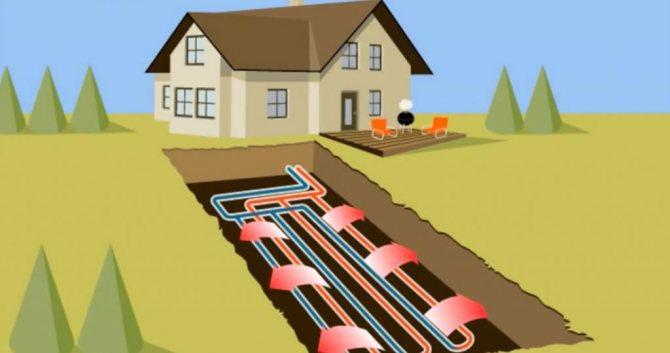

A few years ago, there were only a few free energy devices that seemed to offer robust possibilities for developing cold electricity with your own hands, but today there are at least five significant individual projects that work in varying degrees of yield per unit. Although these various machines or devices in both rotating and solid state classes are based on the classical Faraday / Maxwell principles, they achieve their excess output due to the increased electromagnetic activity within the device or system.
It should be noted that some physicists, trying to discredit some projects of researchers of free energies, propose to abandon Maxwell's mathematics with his new theories and operating machines. After careful analysis of the work, it was found that, instead of discarding the principles of Maxwell's equation, these various machines actually complement or enhance electromagnetic functioning in each case based on Maxwell's second theory:
- One of the main reasons physicists resist the concept of free energy is that the concept of a tachyon field runs counter to special relativity, which limits the speed of particles to the speed of light.
- The tachyon concept (fast particles) was proven based on the results of Professor Gerald Feinberg in 1967. Some of these new excess output machines established the reality of the tachyon field, as evidenced by individual researchers.
- In addition to Professor Feinberg's conclusions about the concept of fast particles, a US Navy research team that conducted various experiments during the 1950s recorded a spot indicator moving across the CRT's visibility screen at 202,000 miles per second, which is impossible to explain.
- These test results were noted as interactions between particles traveling at about 16,000 miles per second. Realizing the constant speed of light (186,000 miles per second), these experimenters rechecked their test setting, but again recorded the same results at 202,000 m / s (particle velocity).
- Since no one could provide an explanation for these findings, the test results simply fell into uncertainty and were marked as unexplained. The result of the experiment in 1913 has also never been satisfactorily explained by modern physicists. In this experiment, two parallel light sources were sent in opposite directions around a closed path, and photographic plates recorded the impact of the light sources. If the basic beliefs of relativity were correct, both light signals could travel these equal closed circular paths (equal to the distance around the earth's surface) at the same time.
Therefore, many physicists and scientists noted that the theory of relativity also requires modifications.
Household thermogenerator
Already in the post-war fifties, Soviet industry began to produce the TGK-3 thermogenerator. Its main purpose was to power battery-operated radios in non-electrified rural areas. The generator power was 3 W, which made it possible to power battery receivers such as Tula, Iskra, Tallinn B-2, Rodina-47, Rodina-52 and some others.
The appearance of the TGK-3 thermogenerator is shown in Fig. 3.
Fig. 3. Thermogenerator TGK-3
Thermogenerator design
As already mentioned, the thermogenerator was intended for use in rural areas, where lightning kerosene lamps were used for lighting. Such a lamp, equipped with a thermogenerator, became not only a source of light, but also electricity. At the same time, additional fuel costs were not required, because exactly that part of the kerosene that just flew into the pipe was turned into electricity. In addition, such a generator was always ready for work, its design was such that there was simply nothing to break in it. The generator could just lie idle, work without load, and was not afraid of short circuits. The generator's lifespan, compared to galvanic batteries, seemed like eternal.
The role of the chimney in the lightning kerosene lamp is played by the elongated cylindrical part of the glass. When the lamp was used in conjunction with a thermogenerator, the glass was made shortened, and a metal heat transmitter 1 was inserted into it, as shown in Fig. four.
Fig. 4. Kerosene lamp with thermoelectric generator
The outer part of the heat transmitter has the shape of a multifaceted prism on which thermopiles are installed. To increase the efficiency of heat transfer, the heat exchanger had several longitudinal channels inside. Passing through these channels, hot gases went into the exhaust pipe 3, simultaneously heating the thermopile, more precisely, its hot junctions. An air-cooled radiator was used to cool the cold junctions. It consists of metal ribs attached to the outer surfaces of the thermopile blocks.
Thermogenerator - TGK3 consisted of two independent sections. One of them produced a voltage of 2V at a load current of up to 2A. This section was used to obtain the anode voltage of the lamps using a vibration transducer. Another section at a voltage of 1.2V and a load current of 0.5A was used to power the filaments of the lamps.
It is easy to calculate that the thermogenerator had a power not exceeding 5 watts, but it was quite enough for the receiver, which made it possible to brighten up long winter evenings. Now, of course, it seems just ridiculous, but in those distant times, such a device was undoubtedly a miracle of technology.
How to make a Peltier element with your own hands
A common Peltier element is a plate assembled from parts of various metals with connectors for connecting to a network. Such a plate passes a current through itself, heating up on one side (for example, up to 380 degrees) and working from the cold on the other.
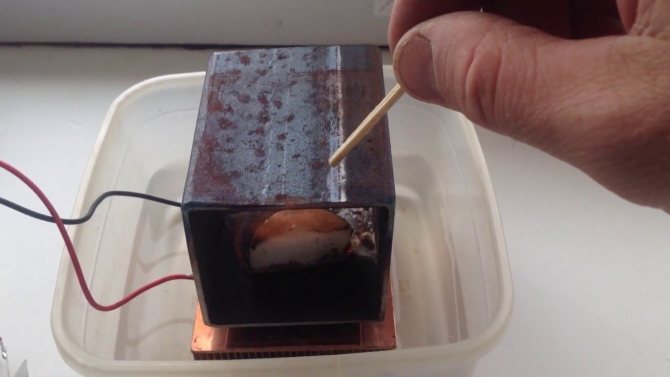

The Peltier element is a special thermoelectric transducer that works according to the principle of the same name for supplying electric current.
Such a thermogenerator has the opposite principle:
- One side can be heated by burning fuel (for example, a fire on a wood or some other raw material);
- The other side, on the contrary, is cooled by a liquid or air heat exchanger;
- Thus, current is generated on the wires, which can be used according to your needs.
True, the device's performance is not very great, and the effect is not impressive, but, nevertheless, such a simple home-made module may well charge the phone or connect an LED flashlight.
This generator element has its advantages:
- Silent work;
- The ability to use what is at hand;
- Light weight and portability.
Such homemade stoves began to gain popularity among those who like to spend the night in the woods by the fire, using the gifts of the land and who are not averse to getting electricity for free.
The Peltier module is also used to cool computer boards: the element is connected to the board and as soon as the temperature becomes higher than the allowable temperature, it starts to cool the circuits. On the one hand, a cold air space enters the device, on the other, a hot one. The 50X50X4mm (270w) model is popular. You can buy such a device in a store or make it yourself.
By the way, connecting a stabilizer to such an element will allow you to get an excellent charger for household appliances at the output, and not just a thermal module.
To make a Peltier element at home, you need to take:
- Bimetal conductors (about 12 pieces or more);
- Two ceramic plates;
- Cables;
- Soldering iron.
The manufacturing scheme is as follows: the conductors are soldered and placed between the plates, after which they are tightly fixed. In this case, you need to remember about the wires, which will then be attached to the current converter.
The scope of use of such an element is very diverse. Since one of its sides tends to cool, with the help of this device you can make a small camping refrigerator, or, for example, an auto-air conditioner.
But, like any device, this thermoelement has its pros and cons. The pluses include:
- Compact size;
- The ability to work with cooling or heating elements together or each separately;
- Quiet, virtually silent operation.
Minuses:
- The need to control the temperature difference;
- High energy consumption;
- Low level of efficiency at high cost.



